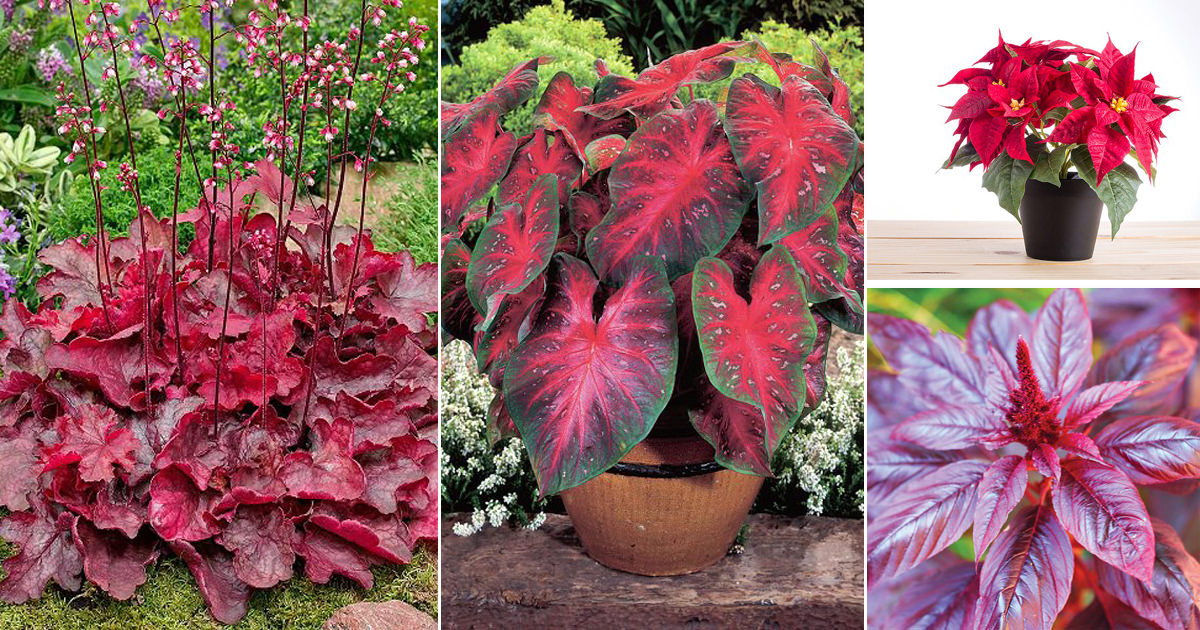Plants with red leaves, a captivating sight to behold, grace the world of flora with their vibrant hues. Their foliage, adorned in shades of crimson, scarlet, and burgundy, paints a stunning canvas in nature’s tapestry.
Beyond their aesthetic charm, these plants hold scientific intrigue. The vibrant red coloration, a result of anthocyanin pigments, offers insights into the intricate interplay between light, temperature, and nutrient availability in plant development.
Red-Leaved Plant Species

Various plant species exhibit vibrant red leaves, ranging from deep crimson to burgundy hues. These colors result from the presence of anthocyanins, a type of flavonoid pigment. Anthocyanins are synthesized in response to environmental cues such as sunlight, temperature, and nutrient availability.
Plant Species with Red Leaves
- Japanese Maple (Acer palmatum): Known for its delicate, deeply lobed leaves that turn brilliant shades of red in autumn.
- Redbud (Cercis canadensis): A small tree with heart-shaped leaves that turn deep red in spring before new growth emerges.
- Red Osier Dogwood (Cornus sericea): A shrub with bright red stems and leaves, particularly striking in winter.
- Virginia Creeper (Parthenocissus quinquefolia): A climbing vine with five-lobed leaves that turn crimson in autumn.
- Smoke Bush (Cotinus coggygria): A large shrub with showy, smoky-pink flower clusters and leaves that turn red in autumn.
The intensity and shade of red coloration can vary within species, influenced by factors such as genetics, soil pH, and light exposure.
Environmental Factors Influencing Red Leaf Coloration: Plants With Red Leaves
/oakleaf-hydrangea-leaf-fall-big-56a583735f9b58b7d0dd3e98.jpg)
The development of red leaves in plants is influenced by a combination of environmental factors, including light intensity, temperature, moisture, and nutrient availability. These factors interact to regulate the production of anthocyanins, the pigments responsible for the red coloration.
Light Intensity
Light intensity plays a crucial role in red leaf development. Higher light intensity promotes anthocyanin production, resulting in more intense red leaves. This is because light triggers the expression of genes involved in anthocyanin biosynthesis.
Temperature
Temperature also affects leaf color. In general, cooler temperatures favor red leaf development. When temperatures are low, the production of chlorophyll, the green pigment in leaves, is inhibited, allowing the red anthocyanins to become more visible.
Moisture
Moisture availability can influence leaf color. Drought conditions can lead to increased anthocyanin production, resulting in redder leaves. This is because water stress triggers the accumulation of sugars in the leaves, which can enhance anthocyanin synthesis.
Nutrient Availability
The availability of nutrients, particularly nitrogen, can affect leaf color. Nitrogen deficiency can promote red leaf development by limiting chlorophyll production. In contrast, high nitrogen levels can inhibit anthocyanin synthesis, resulting in greener leaves.
Horticultural Applications of Red-Leaved Plants

Red-leaved plants offer unique and captivating aesthetic qualities to any landscape. Their vibrant foliage adds a touch of drama and interest, creating a stunning contrast against other plants and garden elements.
Ideas for Using Red-Leaved Plants in Landscaping, Plants with red leaves
Incorporating red-leaved plants into your landscape design can enhance the overall visual appeal and create a variety of effects. Consider the following ideas:
- Focal Points: Plant red-leaved specimens as focal points to draw attention to specific areas of your garden. Their bold foliage will naturally command attention and add a touch of drama.
- Mass Plantings: Create a stunning display by mass planting red-leaved plants in groups or borders. This technique creates a cohesive and eye-catching effect that will add depth and dimension to your landscape.
- Accents: Use red-leaved plants as accents to complement other plants with contrasting colors or textures. For example, pair them with silver-leaved plants to create a striking contrast or with green-leaved plants to add a touch of vibrancy.
Plant Combinations that Enhance Red Leaf Displays
When selecting plants to pair with red-leaved varieties, consider their foliage color, texture, and size. Here are a few harmonious combinations to consider:
- Silver-Leaved Plants: Silver-leaved plants, such as dusty miller (Senecio cineraria) or lamb’s ear (Stachys byzantina), create a stunning contrast against the deep red foliage, enhancing its visual impact.
- Green-Leaved Plants: Green-leaved plants, such as hostas or ferns, provide a backdrop that allows the red foliage to stand out and create a more vibrant display.
- Yellow-Leaved Plants: Yellow-leaved plants, such as goldenrod (Solidago) or Japanese barberry (Berberis thunbergii ‘Aurea’), complement the red foliage and create a warm and inviting atmosphere.
Maintenance Requirements for Red-Leaved Plants
Red-leaved plants generally have similar maintenance requirements as other plants in your garden. However, they may benefit from additional care to ensure their foliage retains its vibrant color:
- Sunlight: Most red-leaved plants prefer full sun to partial shade. However, some varieties, such as Japanese maple (Acer palmatum), can tolerate more shade.
- Soil: Red-leaved plants prefer well-drained, acidic soil. Amend the soil with organic matter to improve drainage and acidity.
- Water: Water regularly, especially during hot and dry weather. Avoid overwatering, as this can lead to root rot.
- Fertilizer: Fertilize red-leaved plants monthly during the growing season with a balanced fertilizer. Avoid using fertilizers high in nitrogen, as this can promote green leaf growth.
